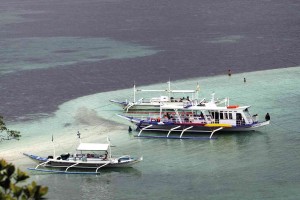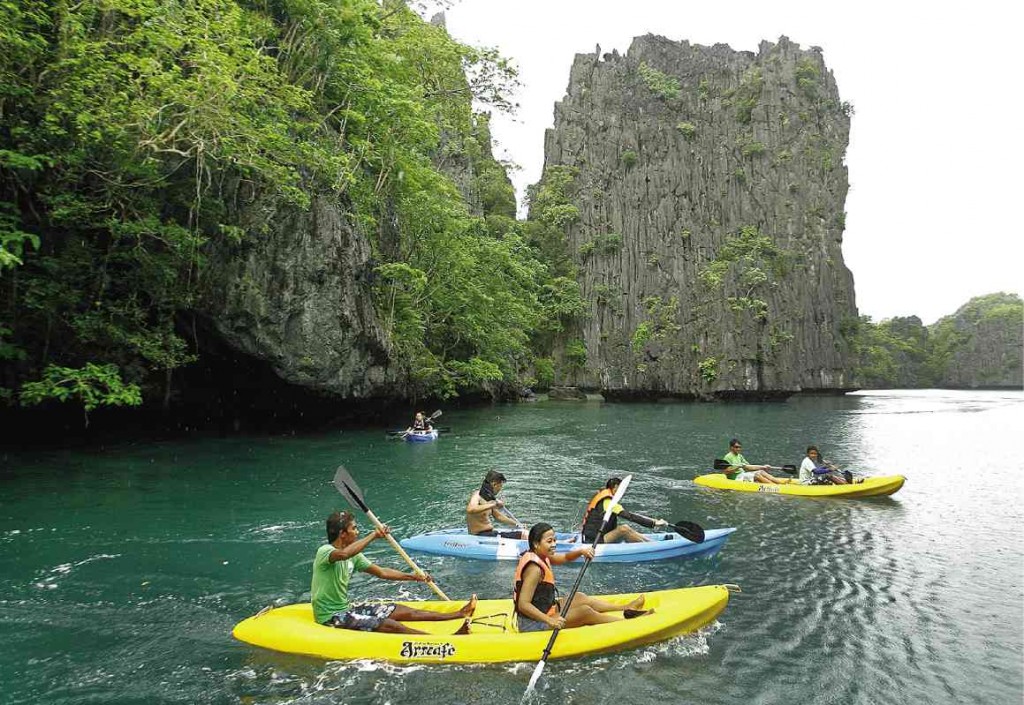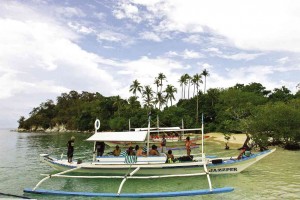Developing El Nido the right way
As more tourists discover the natural wonders the Philippines has to offer, those managing one of the key attractions in the country’s so-called last frontier have a conundrum at their hands.
Should tourists—and the job-creating money they spend—be welcomed, or is the strain on the environment their presence brings really worth all the pain?
Former Tourism Secretary Alberto Lim says the answer lies in the “happiest place on earth,” Disneyland.
“How does Disneyland do it? How do they manage huge crowds, and still manage to not have everyone going to the same place?” he says at a recent tour with journalists.
Depending on a person’s age, Disneyland is either a dream-come-true or an expensive way to spend the day covered in sweat. For Lim, however, Disneyland and other theme parks offer valuable lessons for policymakers managing the country’s tourism sector.
Lim chairs El Nido Foundation Inc., a privately-funded non-government organization that has over the decades worked with Palawan’s government to develop, promote, and protect El Nido.
Nestled between limestone cliffs, El Nido was a sixth-class municipality near the northernmost tip of Palawan. The first real resort for tourists was Miniloc, which was put up in 1993 by a joint venture between Japanese businessmen and the local Soriano Group, which Lim used to work for.
Back then, it was made up of seven cottages built on stilts over the water. “It had rudimentary facilities. Rooms didn’t even have their own toilets,” Lim says.
Until recently, El Nido, named after the soup made of bird’s nests that are harvested from nearby-caves, was fairly secluded from the rest of Palawan. Most commercial flights to Palawan go to the provincial capital of Puerto Princesa—which used to be a 12-hour drive of unpaved roads from El Nido.
Flights of under an hour from Manila to El Nido are also available, but tickets are pricey because supply is tight. The route is served by a boutique airline using 50-seater propeller-engine planes, which are about the largest type of aircraft the town’s short runway can accommodate.
Palawan has also enjoyed (or suffered) a bad reputation over years. Sitting on a separate tectonic plate as the rest of the Philippines, Palawan used to host one of the country’s largest penal institutions. People with leprosy also used to be shipped off to the province. Malaria outbreaks in the past also served as a turn off to most tourists.
As a result of this seclusion, Palawan’s natural resources have remained relatively untouched; its forests remain intact, most of its reefs still teem with marine life, and many white sand beaches remain pristine.
Now, roads have improved and more affordable hotels and inns have been put up, resulting in an influx of tourists, leading to more jobs for the town’s citizens. One drawback, however, is that the growing tourism sector threatens the area’s main attraction: its natural beauty.
Two decades ago, El Nido’s economy depended solely on fishing, with many boatmen using dynamite to get bigger catches. These days, protecting fish, not catching them, has become the town’s bread and butter. Last year, 62,960 tourists came to El Nido, the most the town has ever gotten in history.
“There has been some overcrowding at some sites, especially the popular ones,” El Nido Foundation executive director Irma Rose Marcelo says in an interview. “Right now, tourism is focused on just four tours, when in fact, there are a lot more places to see,” she tells the Inquirer.
These four boat tours, labelled by locals as A, B, C, and D, take visitors to the most popular islands, beaches, and snorkeling areas that El Nido has to offer. Marcelo notes, however, that other unexplored areas are just as scenic.
“There’s no magic number on how many tourists El Nido can accommodate. It’s just a matter of spreading them out and educating them,” Marcelo says.

Spreading tourists out over more sites, however, would be useless if these visitors continue to damage the environment, Marcelo says. Seemingly innocuous things such as taking home small bottles of sand or seashells as souvenirs, touching corals, intentionally or accidentally, and even feeding fish with pieces of bread upset the ecosystem that is El Nido’s main selling point.
The El Nido Foundation, Marcelo says, is one of the local partners of a United Nations Environment Programme project called Green Fins, which seeks to promote “sustainable” snorkeling and scuba diving in ecotourism hotspots in Asia.
Instead of dealing directly with tourists, the Green Fins projects works with scuba dive shops and snorkeling tour operators. Operators of these businesses are trained by Green Fins partners on how “sustainable” scuba diving and snorkeling tours are done.
If this knowledge translates into actual practice, these businesses are accredited by Green Fins as eco-friendly shops.
The Green Fins approach goes beyond training tour operators to tell their clients not to touch corals. To gain accreditation, these businesses are also barred from using dead marine life like clam or turtle shells as storefront decorations. Boats they own must also have proper waste management systems, which include functioning toilets.
“The simplest rules are just don’t touch (corals), don’t feed the fish, and don’t kick over any corals. They’re pretty straight forward but you’d be surprised at how often they are violated,” says Jerker Tamelander, head of the UNEP’s Coral Reef Unit.
The biggest no-no under the Green Fins project is the use of steel anchors at snorkeling and dive sites since the damage this causes to corals can take years to rebuild.
“It’s a code of conduct to mitigate the threats of diving and snorkeling on reefs,” says Samantha Craven of the Reefworld Foundation, the international coordinator of the Green Fins initiative.
Participation in Green Fins is optional. The main upside for resorts and tour operators to becoming Green Fins members is gaining the image of being environment friendly, which can be used as a marketing tool to attract tourists.
“We encourage them to use their Green Fins membership to show that they adhere to best practices,” Tamelander says. Once the project is more well-known among scuba divers and avid beachgoers, Tamelander hopes that businesses with Green Fins membership would be actively sought out by tourists.
Outside of Palawan, the Green Fins project is also being implemented in Boracay, Batangas, Cebu, and Puerto Galera, among others.
“When someone goes to El Nido, they will seek out operators that have the Green Fins logo,” he says.
Tourism’s importance to El Nido cannot be doubted, and because of that, its natural beauty must be protected. “Resorts are buying goods and giving people jobs. It’s the tide that raised all boats,” Lim says.
The only way to secure the town’s enduring success, he says, was to protect the environment—a task that would require the cooperation of all stakeholders.
“The Japanese have an unusual philosophy. I came in with the Soriano group and our Japanese partners told us to take care of the locals and the environment and the (tourists) will follow. It made business sense. It came from the heart too,” Lim says.



